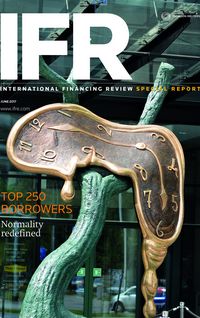When the ECB announced in 2016 that it was expanding its QE to include purchases of European corporate bonds, the news came as a welcome surprise to issuers. The time has now arrived for the bank to step away from its expansive asset shopping spree. It is likely to retreat from the checkout gracefully, however, so do not expect any taper tantrums.
It has been a struggle for the European economy in the last few years. It has had to contend with the fallout from the global financial crisis, frailty in its internal banking sector and fears of sovereign defaults within the member states. Europe has been languishing in a prolonged low-growth, low-inflation cycle.
In its attempts to reflate the economy, the ECB entered into the realms of extreme monetary policy by imposing negative interest rates (dropping the deposit rate to -40bp) and pursuing quantitative easing through its Asset Purchase Programme. That programme was expanded last year from €60bn to €80bn and, in a surprise move, broadened to include European corporate bonds.
The Corporate Sector Purchase Programme was an attempt by the ECB to strengthen the pass-through of its asset purchases into the real economy through buying euro-denominated bonds from investment-grade credits.
The buying began in June of 2016, but the impact of the CSPP had already made itself felt.
Global markets were in turmoil in advance of the move, with stock markets diving through the end of 2015 and into 2016 and credit widening as investors retreated to the safe haven of government bonds.
“Deal flow in January and February was slow,” said Frazer Ross, head of investment-grade credit syndicate at Deutsche Bank. “Fears of a hard landing in China and plunging oil prices severely deterred any risk appetite, and corporate issuance in Europe dried up.”
The number of euro-denominated European corporate issues sold in the market dropped from 44 in November 2015 to just 15 in February 2016, according to Thomson Reuters data. Reflecting the malaise, the iTraxx Europe main index jumped from close to the 70bp mark at the end of November 2015 to a high of just over 125bp by mid-February 2016.
As news spread of the ECB’s decision to target corporate bonds, confidence in credit markets returned with a bang. Whether this was purely attributable to the ECB announcement is questionable, but the appearance of a major investor in the market undoubtedly had an impact.
“I remember the market moving tighter by almost 20% on the day of the announcement,” said Ross. “Although it’s fair to say the market was improving anyway.”
Price changes depend on any number of influences, but the psychological impact of a major buyer standing behind European corporate bonds cannot be ignored.
“The QE programme was a positive surprise for the corporate sector,” said Martin Wagenknecht, head of DCM origination for Germany, Austria and Switzerland at Societe Generale CIB. “It resulted in strong demand for bonds and spreads moved in one direction. Corporate funding conditions have been great.”
It has also been good for DCM desks.
In the period between April 2015 to March 2016, European corporates issued 353 deals amounting to €13.5trn. Between April 2016 and March 2017, those numbers increased to 442 issues and €22trn raised.
My work here is done
As well as issuance picking up during the CSPP period, so have the fortunes of the eurozone economy.
So, just as the ECB timed its intervention to coincide with a market-driven rebound in risk appetite, it looks as if it might be in the fortunate position to be trimming its bond purchases to coincide with an improvement in underlying economic and corporate performance.
The scenario could not be better, as it has to cut back its buying for both fundamental and technical reasons.
“The ECB is keen to stop its asset purchases, as it wants to shift its focus from monetary policy to fiscal policy,” said Luke Hickmore, senior investment manager at Aberdeen Asset Management. “In any case, it is going to find it harder to keep buying, as it will soon start to reach its bond holding limits.”
“The central banks are closing in on their 33% issuer limits in the government bond space,” said Bernhard Gruenaeugl, credit strategist at Commerzbank. “For Bunds, for instance, the limit could be reached early next year under unchanged parameters.”
The slowdown in buying has already started. In April, the ECB reduced its monthly bond purchases back to €60bn from €80bn and there is likely to be news of more to come in the near future.
A gradual approach to its exit strategy is widely anticipated.
“It will continue to taper its purchasing. We are expecting more news on its plans soon, perhaps as early as June and a move in September.” said Hickmore. “By May or June of next year, its buying will have dwindled to just a small number.”
There is still a fair degree of ambiguity as to what the shape of the exit will actually look like, however, and the form of the withdrawal is where the debate is moving.
“What exactly happens when it tapers?,” asked Wagenknecht. “Is it focusing on monthly volumes and reducing or stopping its purchases? Is it reinvesting coupons and redemptions?”
There is unlikely to be a complete halt to its asset purchasing. Pursuing a measured withdrawal gives the ECB the flexibility to adjust its strategy should the market run into any unexpected problems. And there are potential political risks waiting in terms of European elections, Brexit and Donald Trump’s presidency.
“Will we see a knee-jerk reaction?” asked Ross. “No, it’s likely to cut back on its purchases very, very slowly.”
Likewise, a well-communicated programme mitigates the more fundamental impact of a wholesale abandonment of the market.
“If it were a hard stop, the market would go wider.” said Hickmore.
Goodbye gorilla
Nevertheless, as a major investor leaves the European bond market, there will undoubtedly be some impact on the corporate sector. It is inevitable. European corporates are unlikely to be panicking in the face of the ECB’s exit, however. In fact, there is presently little evidence of any change in sentiment, investor behaviour or spreads.
“For the first few weeks in April, the ECB’s corporate purchases continued at an impressive pace. There has been no impact on pricing in primary,” said Marco Baldini, head of European bond syndicate at Barclays.
And there is every possibility that corporate bond purchases will remain buoyant for a while yet in comparison to its efforts in the government bond space.
It should mean that new issues will continue to be heavily oversubscribed in the near term, and perhaps for longer.
“One would expect some kind of widening as a major investor leaves the market, but there is lots of liquidity with investors,” said Baldini. “It could be argued that there will be very little effect on credit spreads overall, especially if we see a higher rates environment which will tempt more investors into the market. ”
Nevertheless, it will take some “puff” out of the market. Since it began its purchases of eligible corporate bonds, the central banks have build up a handsome portfolio through activities in the primary and secondary markets.
“The CSPP has, on average, accounted for 12.5% of the outstanding of each bond in which it’s participated,” said Hickmore. “That’s €86.9bn from 924 bonds issued by 213 issuers.”
It looks impressive, but was it necessary?
“Is there demand to take up the slack?” asked Hickmore. “We think there is plenty.”
That is good news for corporates. And even with the eventual withdrawal of a major source of demand, borrowers are unlikely to feel any immediate need to jump into the market to raise funds. At such low interest rates, paying a few extra basis points is neither here nor there for the top-rated issuers.
So what?
There is no doubt that the ECB’s monetary policy and quantitative easing through bond buying has had an impact on outright yields and credit spreads in Europe.
Low and even negative interest rates have forced investors into looking further afield for returns in terms of ratings and duration. Credit curves for all asset classes have flattened and narrowed as a consequence.
Volatility in the credit markets has also been squashed. With an effective backstop bid lying in wait, the trend has been almost one way. It has favoured a simple “buying on any dips” strategy, a strategy that has rarely been wrong.
“Volatility is at record lows,” confirmed Wagenknecht. “That has been particularly evident at traditionally quiet times of the year and during times of political risk. Spreads just keep grinding tighter.”
Perhaps the most likely sequence of events from the ECB ending its corporate bond buying is the reverse of consequences seen when it began the programme. Particularly, if a strengthening economy also warrants a change to interest rates.
“Where investors were forced into seeking yield, you might see them returning to government bonds from IG credit, and within credit, from high-yield into investment-grade,” said Gruenaeugl.
There are also signs of increasing supply in floating-rate notes, the type of issuance that is normally seen as a safe haven for investors in a rising interest rate environment.
“The markets are pricing in an ECB rate hike for 2018 - which we feel is a bit premature,” said Gruenaeugl. “But in terms of corporate issuance, the share of FRNs has increased and we have seen more longer dated FRNs come to the market.”
There is a sense that interest rates are on the rise globally, and when that change in direction reaches Europe, then there is likely to be a far greater degree of volatility to contend with.
There is an alternative view, though, that has inflation, interest rates and economic growth remaining at low levels for some time to come. And, if inflation fails to trend towards the ECB’s target, then there is the question as to what more stimulus the ECB can provide given its already bulging bond portfolio.
It is, perhaps, still too early to analyse the overall effectiveness of the bank’s asset purchasing policy on the real economy.
To see the digital version of this special report, please click here
To purchase printed copies or a PDF of this report, please email gloria.balbastro@tr.com



